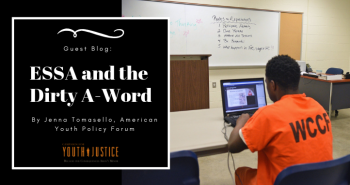ESSA and the Dirty A-Word

By Jenna Tomasello, American Youth Policy Forum
This post originally appeared on AYPF’s Forum for Thought blog.
Accountability means accepting responsibility for one's actions, yet it has become the “dirty word of today’s education reform.” Of recent, conversations about accountability in the education policy sphere have centered around the passage of the Every Student Succeeds Act (ESSA) and its new accountability requirements that replaced the heavy handed “adequate yearly progress” system of accountability under the No Child Left Behind Act (NCLB). ESSA underscores a commitment to high standards for all students, but aims to improve the one-size-fits-all approach to education accountability associated with NCLB. Under ESSA, states must develop a system of accountability within the newly established, more flexible federal guidelines to annually measure several indicators used to hold all public schools accountable for student performance.
At AYPF, all students and all public schools means all, and one traditionally underserved population we are particularly concerned about are youth educated in juvenile justice facilities, especially those facilities receiving public education dollars. Juvenile justice facilities serve approximately 31,000 youth on any given day in the U.S., and these youth often enter with significant educational challenges. These youth arguably need access to quality education and supports the most while in a facility that not only aims to promote participation in secondary and postsecondary education and the workforce, but also reduce the risk of reoffending. We believe ESSA provides an opportunity to develop a statewide accountability system that is inclusive of educational programs and schools within juvenile justice facilities to ensure these youth receive a quality education.
However, accountability is tricky, often viewed and treated more as a punitive system rather than a means to continuous improvement. States have historically struggled to provide quality educational services to youth in juvenile justice facilities for several reasons. First, often a number of different entities—including state or local education agencies, state or local juvenile justice agencies, nonprofit organizations, or private contractors—can be responsible for the provision of education in juvenile justice facilities, leading to inconsistencies in policies and practices across the state. Second, a lack of collaboration and information sharing between state and local education and juvenile justice agencies can create barriers to collecting educational outcome data to inform continuous improvement activities. Third, youth often enter facilities with significant academic deficits, and they are there for varying lengths of time, often less than one full school year. While all of these factors make accountability more challenging, it is still critical for states to ensure that juvenile justice facilities are providing youth with a quality education, while taking into account their unique context and student populations.
To help states think through this challenge, AYPF has teamed up with Council of State Governments’ Justice Center (CSG Justice Center) on a policy brief entitled Leveraging the Every Student Succeeds Act to Improve Educational Services for Youth in Juvenile Justice Facilities. The brief aims to provide state and local policymakers and education and juvenile justice leaders with information about how they can use the accountability requirements under ESSA to improve postsecondary and career success for youth in juvenile justice facilities. The brief intends to accomplish three key objectives:
- Highlight three priorities for states to focus on as they contemplate accountability for education in juvenile justice facilities—data collection and information sharing, accountability system, and accountability measures;
- Provide key questions to help state leaders reflect on current policies, identify gaps, and consider opportunities for improvement; and
- Feature promising state practices, which can serve as examples for other states seeking to improve accountability for juvenile justice facilities as part of their ESSA plans.
AYPF also conducted a 51-state scan (inclusive of D.C.) that consisted of interviews over phone and email with education and juvenile justice agency representatives in each state to better understand the current system structure and accountability of education in juvenile justice facilities. The scan informed the brief and allowed AYPF to better understand the current landscape of education in juvenile justice facilities across the states. AYPF is in the process of developing a suite of resources based on the national trends uncovered by the scan.
We believe ESSA gives states a new opportunity to improve education and workforce outcomes for youth in juvenile justice facilities. The brief can help state and local policymakers and education and juvenile justice leaders start to think about how to design an ESSA-compliant statewide accountability system that is inclusive of educational programs and schools in juvenile justice facilities.
Check out AYPF’s other recent dirty A-word resources on alternative education settings.

